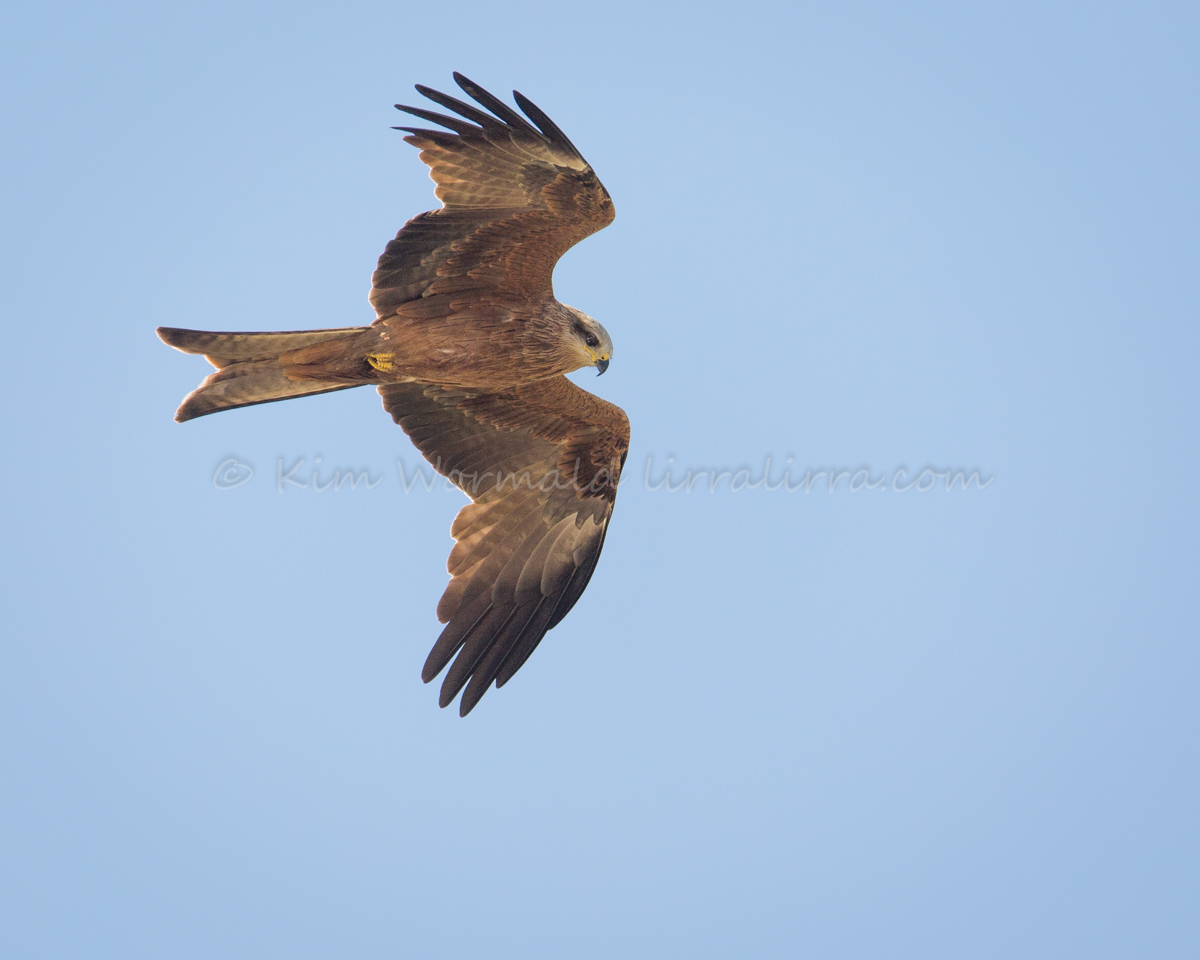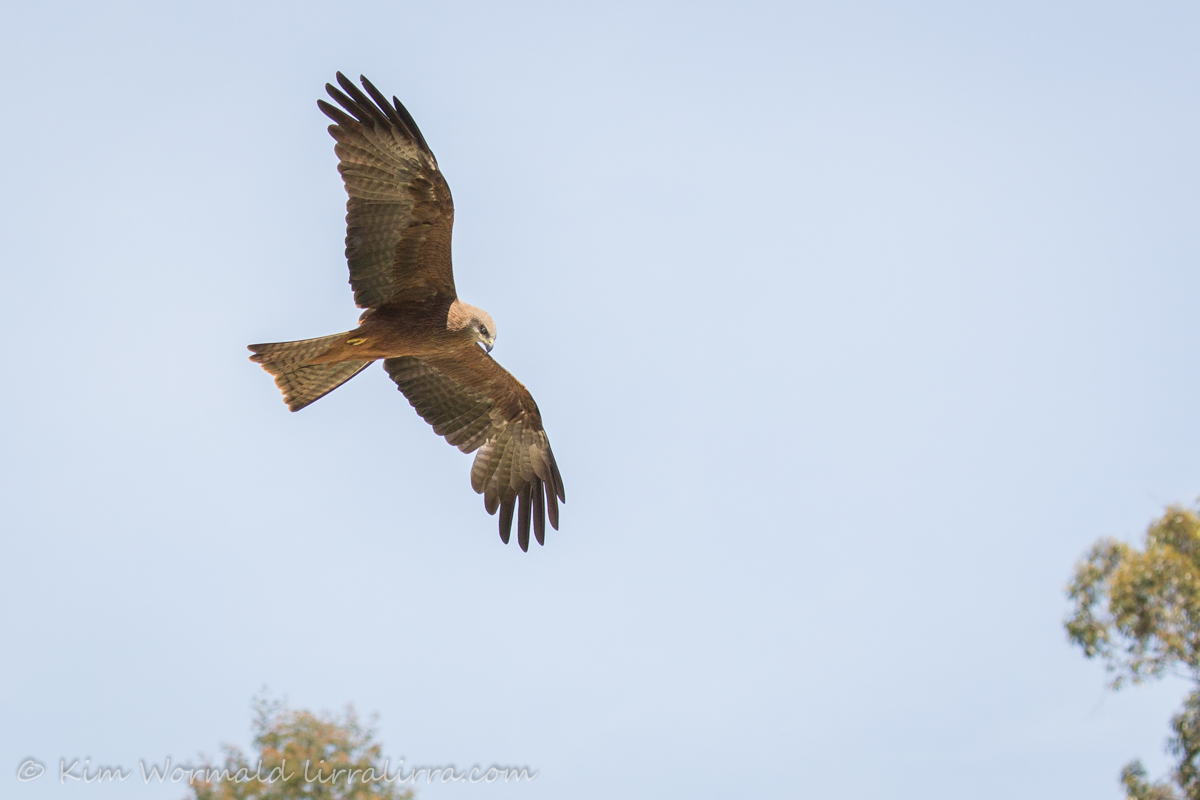A while ago I asked a 5 year old what she’d do if she saw a snake. Her response was hilariously inappropriate, in a loud, dramatic voice she proudly announced “I’d punch it in the head”. So when we were walking together in the bush last week I made sure that the now 6 year old knew more appropriate strategies, which was just as well as within minutes we came face to face with a Red-bellied Black Snake sunning itself on a bank. Later in the week I met the Tiger Snake pictured at the end of this post.
 Black Kite (Milvus migrans)
Black Kite (Milvus migrans)
Canon 5DIII, 1/1600, f/6.3, ISO 800
Black Kites are easily identified by their forked tails; I have taken numerous photographs of them in flight. Sometimes they are so far away that all I capture is a barely identifiable smudge, at other times they are closer and I clip a wing, or closer still and all I’m left with is the tip of a tail in a sea of blue. This session was different and I managed to capture shots with clarity, eye-shine and a little rim lighting evident on the tail feathers and flight feathers. The image shows details of its underparts, dark eye, yellow cere, yellow feet, black bill and the three levels of coverts scalloped along its wings.
The image was taken mid-afternoon when the sun was fairly high, but the kite was flying low and light was reflecting from the stony ground onto its underside.

Black Kite (Milvus migrans)
Canon 5DIII, 1/2000, f/6.3, ISO 800
Black Kites don’t always make their forked tails obvious in flight, sometimes you have to watch them for a while. The image above was taken a little earlier in the day of a different kite. The barring on its flight feathers and tail is clear.
Small groups of Black Kites are commonly seen at the Western Treatment Plant and the species is common across most parts of mainland Australia. They are often seen following harvesting-machinery and at the edge of fires, where they search for disturbed insects and small mammals. During locust/grasshopper plagues Black Kites congregate in flocks of several thousand birds, no other raptor shares this communal behaviour.

Tiger Snake (Notechis scutatis)
Canon 5DIII, 1/2500, f/5.6 ISO 400
Tiger Snakes are common at the Western Treatment Plant and part of the conditions of entry include wearing long trousers; if I was walking through grassy areas on a sunny morning I would probably wear my oilskin gaiters to give added protection. I was out of the vehicle, photographing a Black-shouldered Kite when I saw the little beauty above enjoying the warmth of the road not far from where we were standing. It wasn’t keen to be watched and moved like lightening into some low vegetation and gravelly rocks. Luckily I had the camera set for birds in flight and I managed to capture this image of the snake as it raced away with its forked tongue at full stretch.
Tiger Snakes are the fourth most venomous snake in Australia. They grow to about 1.5m and are variable in appearance, some have much bolder ‘tiger stripes’ than others. Tiger Snakes are viviparous and give birth to 30 or more live young, up to 70 young have been recorded. The vast majority, approximately 95%, of snakes bites are suffered when someone is trying to catch or kill a snake. It’s far better to look before you step, particularly over logs and rocks, and to back away slowly or stand perfectly still if you see a snake – as the little 6 year old now says “You should stand still because snakes don’t bite trees”.
Happy snake-free birding, unless you’re like me and you like seeing them (at a safe distance),
Kim
~ Thank you for visiting and commenting
~ If you would like a weekly email letting you know that lirralirra has been updated please use the ‘subscribe’ box above right

I can’t imagine any of your images being a smudge! LOL The kite shots are amazing and I so know that feeling of getting stunning in flight images – so very hard to get! As for the snake – I absolutely adore what your 6 y/o now says and I would have a hard time living somewhere with so many creepy crawlies I think. But then I’m a chicken not a tree….
But then I’m a chicken not a tree….
Haha! You made me laugh with your ‘chicken not a tree’ comment. I think you’d be safer from a snake if you were a tree. I have lots of smudge images
Hi Kim,
Only a word: MAGIC!!!
Thank you , the very dangerous snake is sublime.
Have a nice week.
Thank you Alain. I hope you have a tres bon week too.
Hello, I’m just writing in the hope that someone could help me, I live in Tasmania & I have a regular visitor whom tries extremely hard to get into our budgie, Cockatiel & Quail avery, on a fairly regular basis, it’s a rather impressive bird, obviously some form of hawk, kite, Eagle or Raptor but my Mum & I haven’t been able to find out what type it is to no fault of our own as we have tried quite extensively to find what form of bird it is in our various native bird etc books. I’m just wondering if anyone could help us out by telling us what type of bird it is if I was able to post a photo of it onto this page at all?? We would be quite appreciative of any help we could get as its a magnificent bird & as I said we have tried quite hard over the past year & a half or more since we first found it trying to break into our avery for a sneaky snack to find what type it is especially as it’s the only bird we haven’t had luck ourselves in finding over the past 30yrs to find out what it is from our bird books etc. It’s also the only one we have seen either here or anywhere else. Thanku so much for your time & I do hope your able to help us out to put this mystery at rest. Kind regards, Claire.
Hi Claire, sorry for the delay getting back to you. Have you looked up Collared Sparrowhawk or Brown Goshawk? To tell between them you need a good look at the shape of the tail, or length of the second toe, some use the eyebrow too. Another possibility is Little Eagle, I had one of them come to an aviary when I was a wildlife carer, but the others do so more often. If you’re on facebook there’s an Aussie bird ID page that would be helpful – I’ve been trying to get the link for you but the internet isn’t good enough at the moment. Please let me know what you find out, or email the images to me (low res) to the lirralirra address on the contact page. Good luck!
Lol! Love that kids comments!
Me too <3
Terrific detail in the first image. I’m undecided about whether or not you should tell the six year old that tiger snakes have extremely sensitive infrared detectors. I found a reference to case studies of tiger snakes on Carnac Island in Western Australia that had been blinded by silver gulls when the snakes were trying to feed on nesting chicks. The snakes were able to survive without a visual system using a combination of sensory inputs for other sensory modalities, including the infrared system. http://www.ukessays.com/essays/biology/the-snake-pit-receptor-in-predatory-terms-biology-essay.php
That is very interesting! Thanks for sending the link, I enjoyed reading it. There is so much in this world that we don’t understand. I guess that snakes would have to feel threatened in order to strike, and hopefully ‘being’ a tree doesn’t threaten them. I think I’ll tell the little one when she’s a bit older.
Great photos, Kim.
The Black Kite photos are so detailed, now we all know what they look like underneath
The snake looks handsome, but I wouldn’t put my hand up to pat it.
Carole.
I read about a program for teaching dogs not to ‘investigate’ snakes, it looked brilliant. I wish it was commonly available, it sounds like you’ve already taken the course
I share your frustration with photographing Black Kites in flight. I’ve had some limited success but need to keep trying. The kites around my home town of Murray Bridge 80km east of Adelaide vary from individuals through to loose flocks of many dozens. I had more success taking photos of the related Yellow-billed Kites in Ethiopia.
As for snakes – I was birding at Nelson (extreme SW coast of Victoria) a few years back when a Tiger Snake slithered over my shoe. I can still feel it. The result – I now firmly believe in being able to run on air!
It’s great that you got good shots of the Yellow-billed Kites, they’d be much harder to get back to than the Black Kites! I shivered and got goosebumps reading about your close encounter with a Tiger Snake.
Several thousand black kites would be an incredible sight. Something to see and cherish forever. To hug to yourself on dark days and darker nights.
I can appreciate snakes from a distance but am not good with them. A red-bellied black lived under the front steps of one our homes and for about nine months of the year I only used the back door.
I have been swimming with snakes too. They swim much better than I do, and my technique was to hold my breath and sink to the bottom till they had gone past… Yes, I know, I am a wimp.
I don’t think you’re a wimp at all! I like snakes, from a distance, but wouldn’t swim with them and think I’d have used the back door too.